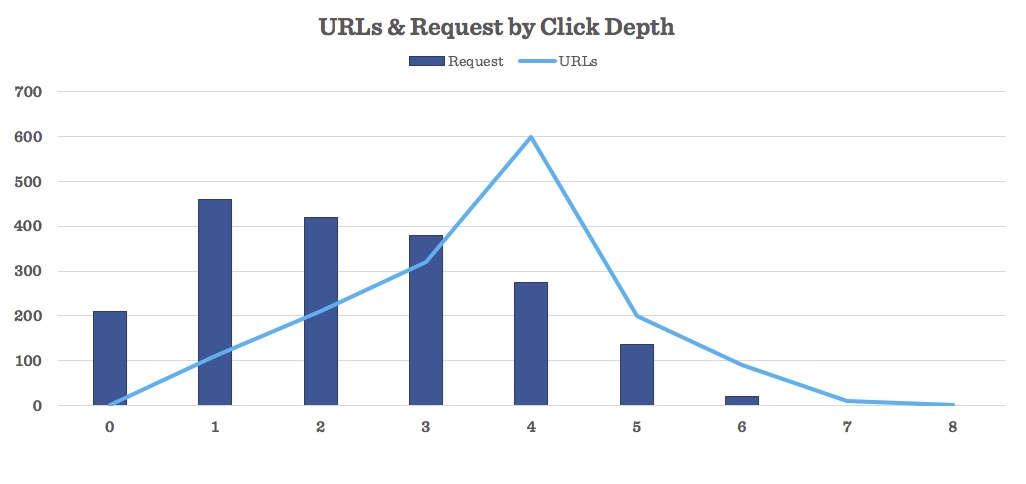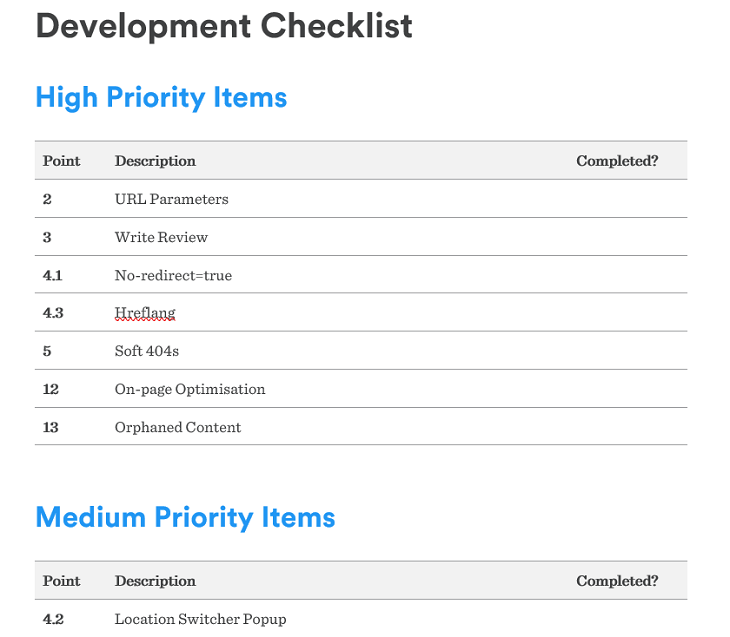Is the advice tailored to you?
While individual approaches may vary, the main objectives of an SEO audit should always be the same:
To highlight issues that are impeding organic performance and identify opportunities that can be leveraged for further growth
This may seem obvious, but it’s something people often seem to lose sight of, with many practitioners relying heavily on cookie cutter templates and following the same predetermined checklist in every audit.
That isn’t to say that templates are inherently bad – consistency in output is important – but usage should ideally be limited to the layout of a document in terms of design and styling, not the content of the audit itself. Ultimately, every site is different, and the exact requirements in terms of scope are never fully evident until the analysis has begun. A lack of flexibility in this regard will ultimately result in important items either being ignored or lightly touched upon, and when this happens the utility of the entire document is often diminished.
Over-reliance on templates can also result in unnecessary items being included in the write-up, something that presumably feels like a “value-add” to the author, but in reality detracts from the more worthwhile recommendations being provided. A relatively common way this manifests itself in practice is the presence of large quantities of filler text introducing an issue or opportunity, followed by a brief sentence explaining that it isn’t applicable to the site in question. Far from being helpful, all this achieves is a client’s time be wasted as they wade through superfluous text to find the advice for which they have paid.
Is it clear why things have been recommended?
As with any type of consulting, when you commission an audit you are essentially buying advice – and this advice only has value if it is acted upon. For this to happen, you need confidence in your supplier. Confidence that they fully understand your business, competitive landscape and website, and that the recommendations provided are the most contextually appropriate.
To achieve this, it is essential that clear explanations are given for every issue/opportunity. There always needs to be strong justification as to why a business should invest their finite resources on a specific recommendation, and how doing so will help them achieve their goals. This reason should never be ‘best practice’. Best practice is not universally appropriate and in no way guarantees that making a change will have a positive outcome.
In order to support any justification, examples specific to the site being reviewed should always be included. At a very basic level, you would expect this supplementary data to be provided within an accompanying spreadsheet and clearly labelled (i.e. a different worksheet per point). But a good audit will typically also include examples within the point itself – e.g. by featuring relevant URLs and images – making things as easy as possible for the recipient. This will help develop understanding, as it will be clearer how something applies to the site in question and is also extremely helpful when ticketing recommendations that require development resource.
Do you know how big each issue is?
One further way to add weight to any justification given during the explanation is to quantify the scale of a specific issue – by putting a number on it. For some points this may be as simple as counting the number of URLs affected, but there are numerous other data sources that are worth including search volume, traffic data, etc.
At Builtvisible, because our audits are usually based on log files, we continually refer back to this data to underline recommendations related to things like crawling, indexing and site architecture, which are relatively esoteric and can be difficult for non-technical marketers to understand.
As an example, the below graph does not just illustrate that a large number of URLs are four or more clicks away from the homepage, it also illustrates the impact this has on crawl frequency.

Are the recommendations feasible?
Following on from a clear explanation, underlined with tangible examples, should of course be the recommendations themselves. It goes without saying that these need to be actionable, by being:
- Relevant – Specific to the business, its website and goals
- Viable – Clear feasibility when taking into consideration the existing setup (e.g. CMS restrictions, available resource, brand positioning, compliance restrictions, etc.)
But more so than this, they should also be granular. Recommendations given will likely need to be communicated to multiple stakeholders to be resolved. Providing detail will give confidence in the recommendations – further increasing the likelihood of adoption – and will reduce the margin for error during the implementation phase.
If, for instance, a company needs to implement Local Business markup to branch pages, then linking to the official documentation will offer some guidance. But it would be far more helpful to deliver a tangible example using one of the branch pages. E.g.
Change Request:
- Introduce Local business markup to the branch URLs.
Vs.
Change Request:
- Introduce Local business markup to the branch URLs.
Add to: Shop page per location
Required Markup:
<script type="application/ld+json">
{
"@context": "https://www.schema.org",
"@type": "ClothingStore",
"name": "Bravissimo",
"url": "https://www.bravissimo.com/shops/manchester/",
"image": "https://images.contentful.com/bz0fvtkbk5r1/szFzWzioBaggMwkKGgSAU/c5f0a0ef70151077e996b66901c4e4a9/Manchester.jpg",
"address": {
"@type": "PostalAddress",
"streetAddress": "40-42 King Street",
"addressLocality": "Manchester",
"addressRegion": "Greater Manchester",
"postalCode": "M26BA",
"addressCountry": "United Kingdom"
},
"geo": {
"@type": "GeoCoordinates",
"latitude": "53.477564",
"longitude": "-2.246029"
},
"openingHours": "Mo, Tu, We, Th, Fr 10:00-18:00 Sa 09:00-18:00 Su 11:00-17:00",
"telephone": "+441618397050"
}
}
</script>One final thing that it is worth discussing is dependencies. Often multiple steps are required for a singular point to be resolved and the ordering of these can be extremely important. Where this is the case, the individual steps should be as clear as possible.
Is there a clear priority order?
With SEO, it is always difficult to predict the impact of a singular change. But that doesn’t mean that it’s acceptable to make no attempt to determine the importance of the recommendations being given.
Businesses, as previously mentioned, have finite resources and continuously need to quantify the effort required to make changes against the potential return. Not providing clear prioritisation makes this difficult and is another major cause of recommendations not being implemented or being deprioritised. Equally, it can result in a business wasting resource on low priority changes, seeing no impact and losing confidence in the quality of the overall recommendations.
Far from being a time-consuming task, in most instances this can be achieved by just introducing a high/medium/low priority ranking.

If something more advanced than the above is required – i.e. a proper forecast – this can typically be provided as a part of an on-going relationship. The undertaking of a strategy project is crucial here to establish demand, competition and the likely return. As with any forecast, predictions are never guaranteed. This is as true for SEO as it is for any other discipline and is why agencies shouldn’t be afraid to forecast, and why clients shouldn’t feel bad about asking for one. Ultimately, regardless of channel, resource is always likely to go to the person who is willing to put a number on something.
Will you get support with making the changes?
Whilst writing a good audit is a bit of an art in itself, the success of a project will almost universally be judged in terms of results and these are reliant on recommendations being correctly implemented. When this doesn’t happen, even the best recommendations will be ineffective; and in some cases, the impact on performance can be disastrous.
For this reason, it is essential that time is factored in for follow-up and QA, and why – for non-ongoing relationships – not paying from this time is a false economy.
As a bare minimum there should be the expectation that every audit will include a good handover meeting, where recommendations can be discussed and scrutinised with the relevant stakeholders, as well as time set aside to review changes on a staging environment before they are pushed live.
Within a longer-term engagement, there is the opportunity to take this a lot further by investing time in learning about team structure and workflows. Gaining access to a ticketing system, for instance, can be extremely beneficial. It gives insight into the format that the development team receiving the recommendations are expecting and makes it easier to address any follow-up questions.
Longer-term relationships also provide better scope to record when changes are made. GA annotations are perfect for this, but other tools have similar features. SEOmonitor, for example, allows you to annotate visibility graphs for either the entire keyword set or a specific grouping. Being able to demonstrate cause and effect in this type of scenario is extremely powerful and will significantly increase the chances of additional recommendations being implemented, as well as further investment within the channel.
So there you have it – six easy to ask questions that really get to the heart of what good SEO auditing looks like. As mentioned this is a distillation, and these questions are very much open to interpretation and to be made your own, but additional scrutiny on these key points will act as good security for your future SEO auditing investments.
If you would like industry-leading support with your technical SEO, assistance building a brief or just a second pair of eyes, feel free to get in touch.

Louis
Bookmarked and took a screenshot of the checklist. Nice one :-)